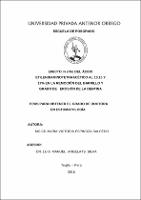| dc.contributor.advisor | Angelats Silva, Luis Manuel | |
| dc.contributor.author | Espinoza Salcedo, María Victoria | |
| dc.creator | Espinoza Salcedo, María Victoria | |
| dc.date.accessioned | 2018-07-10T23:40:39Z | |
| dc.date.available | 2018-07-10T23:40:39Z | |
| dc.date.issued | 2016 | |
| dc.identifier.uri | https://hdl.handle.net/20.500.12759/4203 | |
| dc.description.abstract | El presente estudio evaluó el efecto in vitro del ácido etilendiaminotetraacético al 10,15 y 17% en la remoción del barrillo y grado de erosión de la dentina.
Se evaluaron a 70 premolares uniradiculares con ápices cerrados y divididos en 5 grupos: Grupo I: NaOcl 4% + EDTA 10%; Grupo II: NaOcl 4%+ EDTA 15%; Grupo III: NaOcl 4% + EDTA 17%; Grupo IV: NaOcl 4% y Grupo V: Agua destilada (9ml). Durante la preparación biomecánica se irrigaron con 9ml de NaOcl al 4% y el EDTA (4 ml) por 1 minuto, posteriormente fueron seccionadas en dos fragmentos. Cada muestra fue sometida a un sombreado de monocapa de oro de 200 A (SPI – Module Sputter Coater). Se observaron los tercios cervical, medio y apical en un campo de 10um y de 4000x con el microscopio electrónico de barrido (SEM). Finalmente se evaluó la presencia o ausencia de barrillo dentinario y grado de erosión según los criterios de Torabinejad et al.2
Se encontró que no hubo diferencia estadísticamente significativa al emplear el EDTA al 10, 15 y 17% en la remoción de BD en los tres tercios, pero el EDTA al 10% presento menor remoción. Así mismo se evidencio que el EDTA al 10, 15 y 17% originó erosión dentinaria en los tercios evaluados, siendo mayor en el grupo de EDTA al 17%. | es_PE |
| dc.description.abstract | This study was carried out to assess the effect of 10, 15 and 17% ethylenediaminetetraacetic acid in vitro on smear layer removal and the degree of dentin erosion.
A total of 70 closed apex single-rooted premolars were evaluated and divided into 5 groups:
Group I: 4% NaOCl + 10%, EDTA, Group II: 4% NaOCl + 15%; EDTA Group III: 4% NaOCl + 17% EDTA; Group IV: 4% NaOCl and Group V: Distilled water (9 ml).
They were irrigated during biomechanical preparation with 9ml of 4% NaOCl and EDTA (4 ml) for 1 minute; they were subsequently sectioned into two fragments.
Each sample was subjected to a 200th monolayer gold shading (SPI - Module SputterCoater).
The cervical, middle and apical thirds were observed in a 10um field and 4000x magnification with a Scanning Electron Microscope. Finally the presence or absence of smear layer and degree of erosion were evaluated according to the Torabinejad2 criteria.
No statistically significant difference was found in using 10, 15 and 17% EDTA on smear layer removal in the cervical, medium and apical thirds. But 10 % EDTA removed less SL. It also became clear that 10, 15 and 17% EDTA caused dentin erosion at the three thirds evaluated. Data showed the 17% EDTA caused the most erosion. | en_US |
| dc.description.uri | Tesis | es_PE |
| dc.format | application/pdf | es_PE |
| dc.language.iso | spa | es_PE |
| dc.publisher | Universidad Privada Antenor Orrego | es_PE |
| dc.relation.ispartofseries | D_ESTO_001 | |
| dc.rights | info:eu-repo/semantics/openAccess | es_PE |
| dc.rights.uri | https://creativecommons.org/licenses/by/4.0/ | es_PE |
| dc.source | Universidad Privada Antenor Orrego | es_PE |
| dc.source | Repositorio Institucional - UPAO | es_PE |
| dc.subject | Barrillo dentinario | es_PE |
| dc.subject | Erosión dentinaria | es_PE |
| dc.title | Efecto in vitro del ácido etilendiaminotetraacético al 10,15 y 17% en la remoción del barrillo y grado de erosión de la dentina. | es_PE |
| dc.type | info:eu-repo/semantics/doctoralThesis | es_PE |
| thesis.degree.level | Doctorado | es_PE |
| thesis.degree.grantor | Universidad Privada Antenor Orrego. Escuela de Postgrado | es_PE |
| thesis.degree.name | Doctora en Estomatología | es_PE |
| thesis.degree.discipline | Estomatología | es_PE |
| dc.subject.ocde | https://purl.org/pe-repo/ocde/ford#3.02.14 | es_PE |
| renati.type | https://purl.org/pe-repo/renati/type#tesis | es_PE |
| renati.level | https://purl.org/pe-repo/renati/level#doctor | es_PE |
| dc.publisher.country | PE | es_PE |


